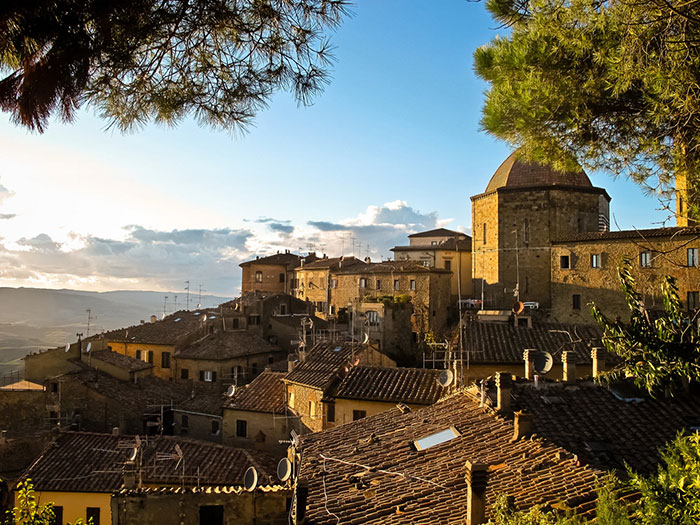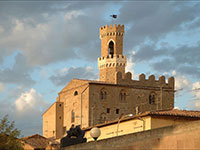Volterra |
In the heart of the town, Piazza dei Priori represents one of the most harmonious and scenic medieval piazzas of Tuscany. The south-west side of the square is dominated by the Palazzo dei Priori, the oldest Town Hall (or Palazzo Comunale) in Italy, built between 1208 and 1257. |
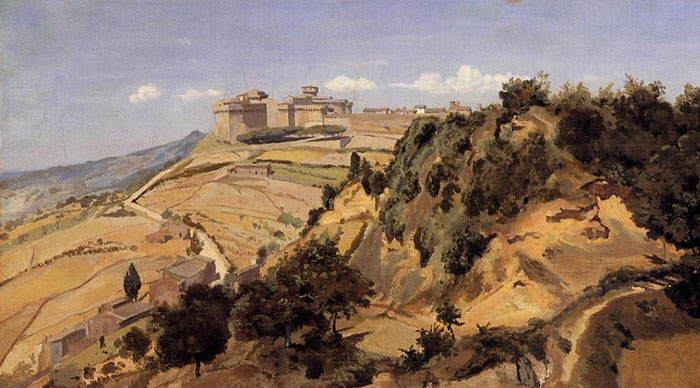 |
||
| Jean-Baptiste Camille Corot, Volterra, a view on the Citadel, 1988, Musée du Louvre, Paris, France |
||
|
||
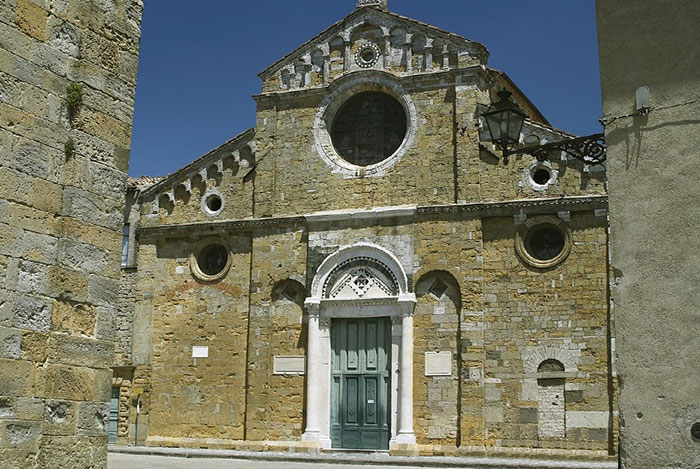 |
||
Volterra, the Duomo or Cathedral of Santa Maria Assunta
|
||
| The church we see now was rebuilt after the earthquake of 1117 that destroyed most of the town, and consecrated by Pope Calixtus II in 1120. Nicola Pisani is said to have been involved in reconstruction in the mid 13th century. The rustic stone facade was built in a Romanesque style and utilizes spolia from the Roman theater of Volterra in the portal. The intarsia over the door is attributed to Nicola Pisano[1] This was not the original Cathedral of Volterra. A prior one, dedicated to San Pietro, and located next the Bishopric was destroyed by the Florentines during a siege in 1472. Reconstructions and alterations of this church occurred over the centuries. In 1580, bishop Guido Serguidi, with approval of the then Ferdinando I de' Medici, Grand Duke of Tuscany, decorated the intricately coffered ceiling of the nave and crossings, designed by Francesco Capriani, carved by Jacopo Pavolini, and gilded by Fulvo della Tuccia. The ceiling has sculpted reliefs with Saints Ugo, Giusto, Pope Linus, Clemente, Attinea, and Greciniana, with a symbol of the Holy Ghost in the center. The belltower from 1493 replaced an older tower. Interior The elongated nave and interior space form a Latin cross. The nave spans 22 columns decorated with stucco simulating rose-colored granite. Much of the interior was restored in 1842-1843. The stucco capitals were completed in the 16th century by Giovanni Paolo Rossetti and Leonardo Ricciarelli. In the 19th century, the walls of the interior were painted in stripes that suggest typical Tuscan decorative church architecture. The floor has tiles of alternating dark and white marble. The Pulpit has three reliefs of Last Supper, Annunciation, and Sacrifice of Isaac and the lions at the base of the columns are undoubtedly 12th century works of the Gugliemo school, perhaps carved by the Pisan sculptor Bonamico. Other elements and the alabaster intarsia were added in 1584, when a prior balustrade was dismantled and the pulpit was reconstructed. To the left of the entrance is the funeral monument of Franceso Gaetano Incontri, former archbishop of Florence. The monument was erected in 1840, with a bust by Arisdemo Costoli and decoration by Mariano Falcini. Below the monument, are eight marble intarsia panels, originally part of a 12th-century Tuscan balustrade. The main altar, mainly dating from 19th century, has a marble ciborium with flanking angels (1471) by Mino da Fiesole. The choir stalls were completed in the 14th century. In the ceiling of the crossing is an God the Father and Stories of the Life of the Virgin (1585) above the choir by Niccolò Circignani. Chapels
The Pinacoteca and Civic Museum of Palazzo Minucci Solaini
|
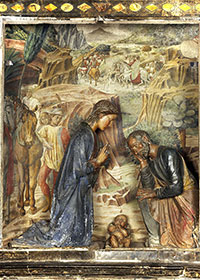 Benozzo Gozoli, Corteo dei Magi con robbiana, Duomo, Volterra 'Vasari, well-known author of the artist’s biographies, points out that Benozzo produced some works in the city of Volterra of which, even in his day, only a small frescoed niche in the Chapel of the Virgin in the Cathedral remained. The subject depicted was the Procession of the Magi, reminiscent of the best-known procession painted by the artist in the Medici Palace in Florence in 1459. This fresco served as the backdrop for a group of terracotta sculptures, attributed to Andrea della Robbia, portraying the Adoration of the Magi, which must have completed the narration of the episode painted by Gozzoli. The sculptures are currently housed in a tabernacle in the same chapel, and have been replaced by another group representing the nativity scene, also sculpted by Andrea della Robbia.' [Serena Nocentini][]
|
|
| Since 1982, the museum has been located in Palazzo Minucci Solaini, a private 15th-century residence. The palazzo houses an extroadinary collection of local paintings and sculptures. The origins of the Volterra Pinacoteca or Art Gallery date back to 1842 when Luigi Fedra Inghirami, who worked in the cathedral, began to collect works of art from various disused churches and monasteries of the city. He gathered the work in the chapel of San Carlo which adjoins the cathedral. In 1905, following a proposal by Corrado Ricci, a municipal art gallery was arranged on the second floor of the Palazzo dei Priori. The more significant works of art from the chapel of San Carlo were exhibited along with other pieces belonging to the city council and to various other institutions of Volterra. Since 1982 the Art Gallery is housed in the Palazzo Minucci-Solaini, a splendid example of late 15th century architecture traditionally attributed to Antonio Sangallo the Elder. Today the Pinacoteca, which represents the most important section of the collection, is complemented by the Municipal Museum. The scope of the latter is to conserve and exhibit important works of art belonging to institutions which are no longer able to provide adequate care. The Deposition by Rosso Fiorentino is the most significant work from the collection. Other important works in the collection are paintings by Taddeo di Bartolo, Alvaro Pirez and Cenni di Francesco, the Pietà by Francesco Neri of Volterra, a predella of the story of the Virgin by Benvenuto di Giovanni, two wooden sculptures by Francesco di Valdambrino, an altar piece of Christ in Glory by Domenico Ghirlandaio and the Holy Conversation and the Annunciation by Luca Signorelli from Cortona. There is also a noteworthy collection of medieval sculpture and ceramics, of medals (especially the Medici collection) and of coins. The Art Gallery organizes conferences, seminars and temporary exhibitions in collaboration with other institutions, with particular attention to the city’s cultural heritage. Didactic activity aimed in particular at schools, offers guided tours of the museum for students at every level.
Palazzo dei Priori |
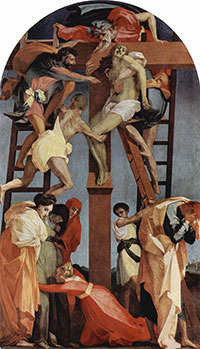 Rosso Fiorentino, Deposition, 1521, oil on wood. Pinacoteca Comunale di Volterra |
|
| The Palazzo dei Priori was built in the 13th century and is one of the most ancient City Halls or "Palazzo Comunale" of Tuscany. The Council Chamber (Sala del Consiglio Comunale), on the first floor up two steep flights of steps, can be visited between 10.30 and 17.30 (modest charge). There is a rather damaged 14th century fresco of the Annunciation on the end wall. n the next room, on the left wall, there is a bit of detached fresco with a rather beautiful painting by Luca Signorelli 1441-1523) of St Jerome.
|
|
|
| The Guarnacci Etruscan museum has important displays of pre-historic, Roman and Etruscan artifacts. The main body of the museum houses many fine objects from the Etruscan period discovered in the Volterra region. The pride of the Guarnacci Museum is its collection of 600 Etruscan funerary. The suggestive actuality of the elongated form of the Ombra della Sera (Shadow of the evening), or the disturbing expression on the faces of the ageing couple figured on the Urna degli sposi (Urn of the married couple) are reason enough to visit the Guarnacci museum, one of the earliest public museums in Europe. Ombra della sera' is a bronze statuette from the old Etruscan city of Velathri n the Guarnacci Etruscan Museum. The title Ombra della sera, comes from the 19th-Century Italian poet and journalist Gabriele d'Annunzio. It seems that D'Annunzio thought the statue looked like the long shadows thrown by a man at sunset — thus 'Evening Shadow'.Viewers of the Evening Shadow have drawn comparison between the form of the statue and the more recent sculpture of Swiss artist Alberto Giacometti. In the 1950s, Giacometti went through a period of sculpting statues in a stretched and elongated style, obsessing over an inner vision of perfection and whittling away material to a point of utter emaciation. [3]
Palazzo Incontri-Viti |
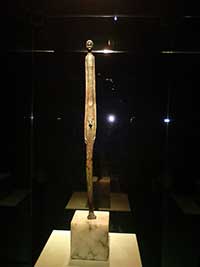 Ombra della sera (Shadow of the evening), Guarnaccii Etruscan Museum, Volterra. The ancient figurative art of Etruscans had a strong artistic influence on Swiss sculptor Alberto Giacometti. |
|
| The Palazzo Viti in via Dei Sarti is one of the most beautiful private residences of Italy. Twelve rooms open to the public, beautifully furnished with furniture, porcelains, alabaster collections and other valuable items representing Italian, European and Oriental art dating from the 15th to the 20th centuries. This collection includes a large number of original drawings on rice paper of the nineteenth century, depicting scenes of Chinese life. The construction of the palazzo began at the end of the 16th century by a nobleVolterran, Attilio Incontri, minister to the Grand duke of Tuscany. The façade, attributed to Bartolomeo Ammannati , is forty three metres in length and sixteen metres wide. Two incomplete wings enclose two small inner courtyards. Benedetto Giuseppe Viti, an alabaster merchant and extensive traveller, purchased the palazzo in 1850 and made radical changes to the interior. Further renovations were carried out in preparation for the royal visit of King Vittorio Emanuele in 1861. In 1964 Luchino Visconti filmed a part of the Vaghe Stelle dell’Orso or Sandra (Of a Thousand Delights) with Claudia Cardinale, in the palazzo. The film awarded the Leone d’oro at the Venice film festival.
|
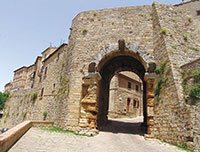 Porta all'Arco |
|
|
Enlarge map of Volterra |
||
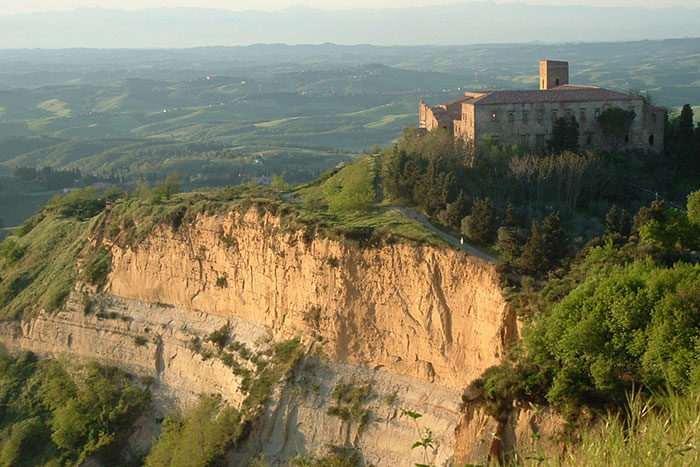 |
||||
| Volterra, balze | ||||
| Perched on a craggy hilltop with vast views over bare grey hills or balze, the mediaeval town of Volterra remains largely intact. But 2 km northwest of town is a deep, eroded limestone ravine called the Balze. Within the area there have been landslides and sink holes as the land continues to fall away. It seems to have begun in the 17C and even most of a rural monastery has been engulfed. |
||||
Comune Volterra |www.comune.volterra.pi.it Walking in Tuscany |Maps San Gimignano - Colle Val d'Elsa - Poggibonsi, Edizioni Multigraphic, 1:25,000 San Gimignano - Volterra, Litografia Artistica Cartografica, 1:25,000 Map of one of Tuscany's most visited areas, with hiking and mountain bike routes, plus on the reverse street plans of San Gimignano and Volterra. [1] Photo Andrés Nieto Porras [2] Camille Corot (French painter) Encyclopedia Britannica | www.britannica.com [3] L'Ombra della sera's origin in the pre-history of Etruscan civilisation makes it nigh on impossible to know for sure why someone might have created this piece of captivating art. Experts pose possible theories — such as those outlined below; but, other stories circulate too. Votive Art The Etruscans may have practiced the tradition of dedicating figurines in the worship of their gods — just as the Romanscertainly did after them. While simple prayer might suffice to appease the gods, to dedicate a piece of art, like a statue, and leave it at the place of worship could considerably enhance the supplicatory act. Holy sites would, as a result, accumulate many votive offerings like the Ombra della sera, for modern day archaeologists to uncover and puzzle over. Little God Lares served as small gods or household spirits for Roman families. The Lar came in pairs and would participate in all the key events around the household, including the family meal. While the specifics around the Lares have been muddied somewhat with the passage of time, these statuettes provided a vital function within the household, exerting a beneficial influence. Pictorial records of the Etruscans, such as the wall painting at Tomba dei Leopardi, suggest the Romans may have adopted the idea of the Lares from their predecessors. While no more certain than any other theory about the Ombra della sera, the possibility exists that this exquisite figure might just be an example of an Etruscan house spirit. [Source: Ombra Della Sera - An Etruscan Statue | www.bbc.co.uk]
|
||||
Spectacular panoramic scenery in the Tuscan Maremma
|
||||
|
||||
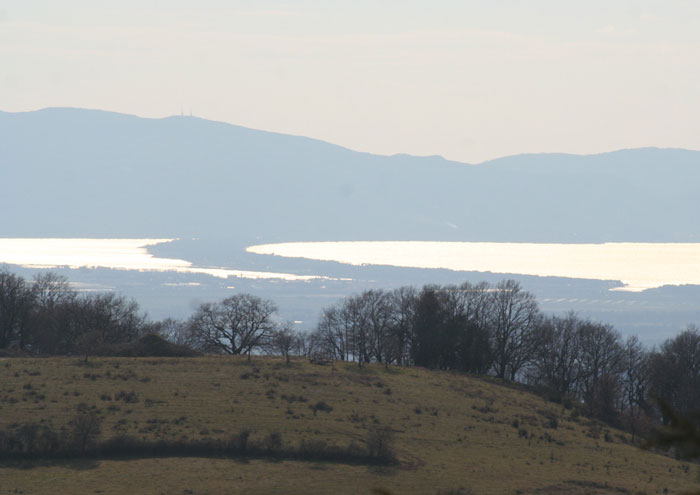 |
||||
Podere Santa Pia is a peaceful retreat, perfect for relaxing with magnificent panoramic views of the mystical Maremma hills up to the Mediterranean Sea and Montecristo. |
||||

